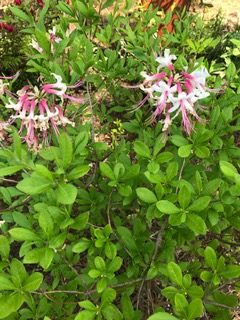Rhododendon canescens, commonly called mountain azalea, piedmont azalea, hoary azalea or Florida pinkster, is a large deciduous shrub that is native to moist woods, swamp margins, and along streams from North Carolina to Florida. It can be found growing as far west as Texas. Mountain azalea prefers acidic, humus, organically rich, moist, well-drained soil in partial shade. Foliage may scorch in full sun. Plant in an area protected from strong winter winds. Mountain azalea does not like wet feet; however, its roots must never be allowed to dry out. Mountain azalea naturalized slowly by root suckers.
Mountain azalea is in the family Ericaceae. It grows 6-feet to 8-feet tall in cultivation and has clusters of fragrant, funnel-shaped, pink flowers in early spring as the foliage begins to emerge. Pistols and stamens of each flower protrude well beyond the corolla in an upward arch.
The genus name comes from the Greek words rhodo meaning rose, and dendron meaning tree. Transferred from the Greek name for Nerium oleander. www.missouribotanicalgarden.org
Mountain azalea is susceptible to aphids, borers, lacebugs, leafhoppers, mealy bugs, mites, nematodes, scale, thrips, and whitefly. Possible diseases are canker, crown rot, root rot, leaf spot, rust, and powdery mildew. Planted in the proper environment with proper care, the mountain azalea will have few problems.
Hummingbirds and swallowtail butterflies are attracted to the blooms. Members of the genus Rhododendron support the specialized bee Andrena (Andrena) cornelli. www.ces.plants.ncsu.edu
Mountain azalea is at home in a woodland garden, shade or native garden or as a specimen and will be added to the Brunswick County Botanical Garden this year.
Information and photos by Jeanne Pavero


